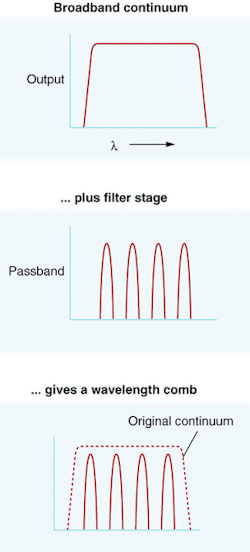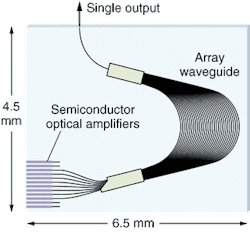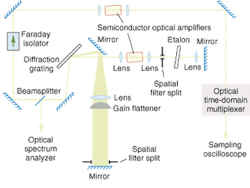Multiple-wavelength sources may be the next generation for WDM
Wavelength-division multiplexing normally requires a separate light source for each wavelength. Tunable lasers don't eliminate that requirement; they just simplify the logistics of stocking and sparing separate parts for each wavelength. Some developers are already looking a step beyond tunable lasers to light sources that could simultaneously generate optical carriers at many separate wavelengths on the WDM grid. Some have already been demonstrated, but the technology is still in the early stages and applications remain quite limited.
The general goal is to generate a comb of regularly spaced optical wavelengths or frequencies on standard optical channels (see Fig. 1). A few approaches include ways to modulate the carriers directly with a signal, but so far most merely generate the wavelength comb.
Most multiwavelength sources fall into three basic categories. One simple concept is to integrate diode lasers oscillating at different wavelengths on a single chip—but that merely integrates multiple lasers on a single substrate, and won't be discussed further. A second approach is to generate a continuous spectrum covering a broad range of wavelengths, then slice that broadband emission into a number of discrete optical channels that can then be modulated with signals. A third alternative is to create a type of optical cavity that allows a laser source to oscillate simultaneously on multiple wavelengths.
Ultrafast sources and bandwidth
One way for a laser to generate a broad range of wavelengths is to emit ultrashort pulses. The spectral bandwidth of a pulse increases as its duration decreases as a consequence of the uncertainty principle, until it is limited by the gain bandwidth of the laser medium. Modelocking constrains laser oscillation so an intense pulse of photons bounces back and forth through the cavity, emitting a brief burst of light each time the circulating photon pulse hits the output mirror. Pulses are separated by the time it takes the light to make a round trip through the laser cavity, so they have a characteristic repetition rate that equals the cavity transit time.
When viewed in the wavelength or frequency domain, modelocking locks together all longitudinal modes that fall in the laser's gain bandwidth. The longitudinal modes have nominal frequency separation that equals the number of cavity round trips per second. However, the transform limit of the pulse duration spans many modes, so single modes can't be isolated from single modelocked pulses. Further processing is required to isolate individual optical channels.
In one early experiment, Lucent Technologies Bell Labs (Murray Hill, NJ) passed 100-fs pulses from a modelocked erbium-fiber ring laser that spanned a 70-nm range through 20 km of standard single-mode fiber. The chromatic dispersion of the fiber stretched the pulse to 20 ns, chirped so the long wavelengths lead the shorter ones. An electro-optic modulator then sliced the stretched pulse into a series of short pulses regularly spaced in wavelength, generating more than 100 usable channels.1 Although that technique has yet to prove practical, it did show the potential of slicing broadband emission into multiple optical channels.
One alternative reported at this year's OFC (Atlanta, GA) is actively modelocking an erbium-fiber laser so its spectral width covers several optical channels. Earlier demonstrations have been limited, but this year R. Hayashi and colleagues at the University of Tokyo were able to obtain 13 wavelengths spaced 100 GHz apart by passing the output through an arrayed waveguide.2 However, they had to use only polarization-maintaining fiber, and cool the amplifying fiber to 77 K.
Supercontinuum sources
The gain bandwidth of the laser material limits the maximum spectral width of a laser pulse, and thus its minimum possible duration. Self-phase modulation in a nonlinear optical material can extend the spectral bandwidth further, to allow generation of shorter pulses. Variations in the light intensity during the pulse modulate the refractive index of the nonlinear material, stretching and compressing lightwaves propagating through the material. Strong broadening produces a supercontinuum, which can stretch over a wide range.
For fiberoptic applications, the supercontinuum is generated in an optical fiber, which concentrates light in the core to reach high intensity. In fibers with high total chromatic dispersion, the pulses spread out along the fiber, as in the early Bell Labs experiment. To prevent that dispersion along the fiber, and to keep the output coherent—necessary to limit timing jitter—the net fiber chromatic dispersion should be near zero.
Microstructured or "holey" fibers with very high nonlinearity have been used in several supercontinuum demonstrations (see Laser Focus World, May 2003, p. 99). However, these holey fibers generally have zero dispersion near 800 nm rather than at standard WDM telecommunications wavelengths. The development of conventional fibers with controllable high nonlinearity and zero dispersion at longer wavelengths has stimulated a new round of supercontinuum demonstrations near 1550 nm.
At this year's OFC, Jeff Nicholson of OFS Laboratories (Murray Hill, NJ) reported highly coherent supercontinuum emission from a 6-m length of highly nonlinear fiber.3 To make chromatic dispersion uniformly low across a broad range of wavelengths, the OFC group drew segments with different dispersion characteristics and spliced them together so the total cumulative dispersion was low, keeping the supercontinuum output coherent. This let them generate the broadest supercontinuum on record, spanning more than an octave, from 1100 to 2200 nm when pumping with a 100-fs modelocked fiber laser.
The high peak powers of modelocked lasers help to generate a supercontinuum, but another team at OFS showed that tens of watts from a continuous-wave fiber Raman laser could generate a 247-nm supercontinuum. It wasn't easy, however. The OFS team needed a kilometer of the highly nonlinear fiber.4
One significant limitation of such broadband sources is that they generate a continuum, which must be sliced to generate discrete WDM channels (see Fig. 2).
Multiple-wavelength cavities
An alternative approach is putting a laser gain medium inside a cavity that allows oscillation on multiple longitudinal modes within its gain bandwidth, ideally with a frequency separation that matches a standard WDM grid. The output of a continuous-wave (CW) modelocked laser is one example. Viewed in the time domain, it is a series of time pulses at regular intervals. Transformed into the frequency domain, it is a comb of regularly spaced wavelengths. Each of these wavelengths is a stable longitudinal mode of the CW laser, and in fact they are all emitted by the modelocked laser.
Viewed in the frequency domain, modelocking maintains the coherence of the different frequency CW signals so they interfere destructively most of the time, and add together to produce light only during the modelocked pulse. Separating the optical channels generates CW signals on the different modes, an effect GigaTera (Dietikon, Switzerland) uses in a commercial multiwavelength laser.5 Another example is a multimode Fabry-Perot diode laser, which has separate narrow emission peaks for each mode, although these peaks are not stable in amplitude or wavelength. A variety of other types have been demonstrated.
One approach integrates an array of broadband semiconductor optical amplifiers and an arrayed waveguide multiplexer within a Fabry-Perot resonant cavity. Each amplifier is connected to one channel of the multiplexer, so driving that amplifier causes oscillation at the peak of the passband of that channel. This arrangement couples outputs at all wavelengths into a single output waveguide with low loss (see Fig. 3). Single-mode operation at 1 mW has been demonstrated with linewidths below 1 MHz and side-modes suppressed by more than 50 dB.6 The cavities, however, are relatively long, so direct modulation is limited to speeds below 1 GHz. Refinements to the design arrange the optical cavities to include a pair of semiconductor amplifiers, so a 4 × 4 array of amplifiers can be tuned to emit on any of 16 wavelengths. Each amplifier, however can oscillate on only one wavelength at a time, so that design is limited to emitting at most four wavelengths at once.7
Another approach is modelocking a semiconductor optical amplifier in an external cavity that includes an intracavity etalon and a spatial filter that broadens the spectrum to 20 nm (see Fig. 4). Etalon transmission peaks set the oscillation wavelengths of each mode, and the relatively weak output is amplified with a semiconductor amplifier. A demonstration with gallium arsenide sources generated 168 optical channels at 50-GHz spacing from 823 to 843 nm. An external optical time-domain multiplexer multiplied the 750-MHz internal modelocking rate and output pulse rate on each channel to 6 GHz.8
Raman ring lasers also can generate multiwavelength combs when suitable filters such as long-period fiber gratings are placed within the ring. The long-period gratings split transmitted light between core and cladding modes, which are recombined after passing through a certain length of fiber. Interference between the two sets of modes generates a series of regularly spaced wavelength peaks. The developers say the same concept could be applied to erbium-doped fibers.9
Prospects for multiple-wavelength sources
Many important issues remain to be tackled before multiwavelength sources become practical. Both wavelengths and amplitudes need to be stabilized. Many multiwavelength oscillator designs have been developed mainly for use as tunable lasers, which need to emit only one wavelength at a time. There has been less immediate demand for simultaneous emission.
Although a few designs can be modulated internally at modest rates, others require external modulation of each channel separately, which is a concern as long as external modulators are relatively costly. Integration of multiple semiconductor lasers on the same substrate may prove a more practical alternative for some applications.
Still, multiwavelength sources do hold an intriguing possibility of simultaneously driving many optical channels. In the long term, their real allure may be for access networks, in which transmission rates are modest and costs are a prime concern.
REFERENCES
- J. B. Stark et al., Phot. Tech. Lett. 9, 1170 (Aug 1997)
- R. Hayashi et al., Paper TuL6, Tech. Digest OFC 2003, 239.
- J. W. Nicholson et al., to appear in Optics Lett. (April 15, 2003; OFS -OFC).
- A. Abeeluck et al., Paper ThT1, Tech. Digest OFC 2003, 561.
- M. Brownell, at www.gigatera.com.
- M. K. Smit, paper presented at ECOC 1999.
- J. H. den Besten et al., IEEE Phot. Tech. Lett. 15, 368 (March 2003).
- M. Mielke et al., IEEE Phot. Tech. Lett. 15, 501 (April 2003).
- Y.-G.Han et al., IEEE Phot. Tech. Lett.15, 383 (March 2003).




